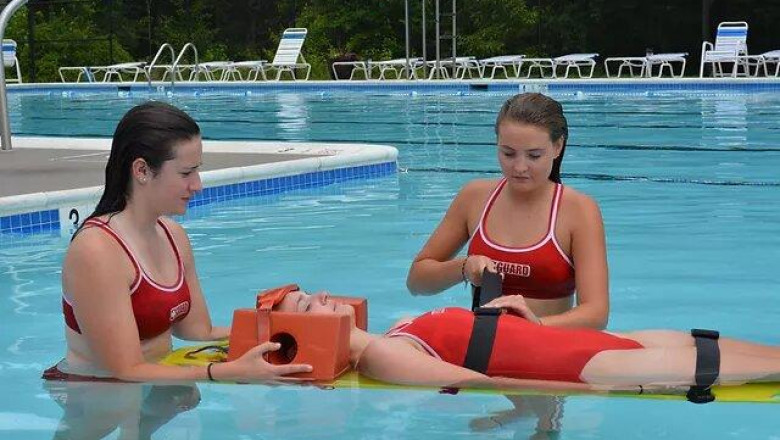views
As the world continues to evolve, so does the role of a lifeguard. In 2025, lifeguarding is no longer just about keeping a watchful eye on swimmers. It’s about mastering technology, adapting to new health standards, and becoming a proactive leader in public safety. Whether you're new to the field or a seasoned guard planning ahead, understanding emerging trends is crucial for staying relevant and effective.
Below are 9 key trends shaping the future of lifeguarding in 2025—every aspiring and working lifeguard should take note.
1. Advanced Surveillance and AI-Driven Monitoring
Technology is reshaping the pool and beach environment. AI-based drowning detection systems are now assisting lifeguards with real-time alerts. Cameras equipped with machine learning can recognize unusual swimmer behavior, helping lifeguards respond faster and more efficiently.
Why It Matters: These tools do not replace lifeguards but support them by minimizing response time and enhancing safety.
2. Emphasis on Mental Health Awareness
Lifeguards are increasingly trained not only in physical rescue but also in recognizing signs of psychological distress—both in swimmers and themselves. Stress, anxiety, or panic attacks are becoming common incidents, especially in crowded public spaces.
Why It Matters: A mentally aware lifeguard is better equipped to de-escalate incidents and maintain a calm environment for everyone.
3. Climate Change and Its Impact on Water Safety
Extreme weather patterns, unpredictable tides, and rising temperatures are creating new challenges for outdoor lifeguarding. From stronger riptides to unexpected storm surges, guards must now be more weather-conscious than ever.
Why It Matters: Being informed about environmental changes ensures timely decision-making and proactive prevention of water-related accidents.
4. Hybrid Training: Virtual + In-Person Certification
Traditional lifeguard training has gone hybrid. Future lifeguards in 2025 are learning CPR, first aid, and rescue techniques through interactive e-learning platforms before attending hands-on practical sessions.
Why It Matters: This approach improves accessibility, flexibility, and retention of core concepts while still prioritizing in-person skills validation.
5. Expanded Roles Beyond Water Safety
Modern lifeguards are taking on leadership roles in emergency management, guest services, and health compliance. They’re being cross-trained to handle a variety of responsibilities, from managing crowd behavior to enforcing hygiene protocols.
Why It Matters: A versatile lifeguard is more valuable in today’s dynamic environments—especially in aquatic centers and large public venues.
6. Eco-Friendly and Sustainable Operations
Sustainability is now part of safety. Lifeguards are expected to support eco-friendly practices such as reducing plastic use, managing water waste, and promoting environmental education at beaches and pools.
Why It Matters: Environmental stewardship helps protect natural resources and reinforces the community-oriented nature of lifeguarding.
7. Increased Demand for Multilingual and Culturally Aware Guards
As global tourism rebounds and communities become more diverse, the ability to communicate with swimmers from various cultural backgrounds is essential. Multilingual guards and culturally sensitive communication are becoming standard in large facilities.
Why It Matters: Clear communication prevents accidents and ensures all visitors feel safe and respected.
8. Fitness and Performance Standards Are Evolving
Lifeguards in 2025 are expected to maintain high fitness levels through ongoing performance checks and functional Lifeguard fitness programs. This includes swimming endurance, strength training, and agility drills.
Why It Matters: Stronger, more agile guards are better prepared for fast-paced, high-stakes rescues in a range of settings.
9. Real-Time Communication Systems
New communication tech, such as waterproof radios, mobile emergency apps, and integrated alert systems, is being widely adopted. These tools keep guards connected with supervisors, medics, and emergency responders at all times.
Why It Matters: Instant communication reduces confusion and ensures a coordinated response during emergencies.
Conclusion
Lifeguarding in 2025 is no longer just about being physically present at a waterbody—it’s about being alert, adaptable, and technologically aware. From AI to mental health training, the scope of the profession has expanded significantly. To remain effective and respected in the field, future guards must stay educated, train consistently, and embrace the changes coming their way.
Staying informed about these trends will help lifeguards not only meet industry standards but exceed them—providing safer, smarter, and more inclusive environments for all.













Comments
0 comment